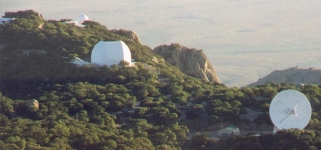
The instruments of the MDM Observatory, the 2.4m Hiltner telescope and the 1.3m McGraw-Hill telescope, are located on the southwest ridge below the summit of Kitt Peak (a location shared with the NRAO 12-meter millimeter telescope and the Kitt Peak VLBA antenna). MDM originally stood for Michigan-Dartmouth-MIT, but with changes in direction and institutional support, some of the players have changed so that MDM doesn't actually stand for anything any more. The 2.4m building is just at the left edge of this view from the KPNO 4-meter gallery, with the 1.3m in the white dome near the top and the two NRAO instruments farther to the right.

Here is a Google Maps satellite image of the Kitt Peak southwest ridge from TerraServer. The two MDM buildings are to the southwest of the NRAO 12-meter dome.
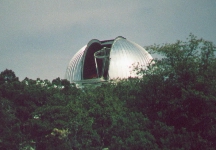
| 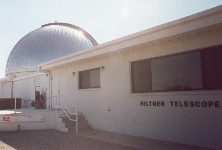
|
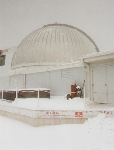
|
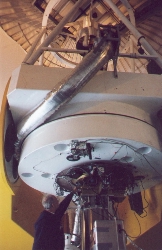 We've gotten some near-IR imagery of the galaxy pairs in our
dust-opacity project, courtesy of colleagues at Ohio State. The
2.4-meter Hiltner telescope is equipped with one of the largest-format IR arrays on
the planet, called TIFKAM (The Instrument Formerly Known as Mosaic)
to avoid confusion with the NOAO Mosaic camera when a detector-sharing
arrangement went into effect. However, when it makes the trip up to the
summit for use on the NOAO telescopes, it magically morphs into ONIS
(OSU Near-Infrared Imager/Spectrometer). As one example of the images it
produces, here's the spiral galaxy NGC 3521, which is noteworthy because
its large bulge backlights the dust in its outer disk. This 2.2-micron
K band image is unusual in that the spiral arms remain prominent
into the near infrared, which suggests that they are in part truly
stellar-dynamical features and not solely sites of enhanced star formation
in an otherwise uniform stellar disk. This instrument also furnished
some of the only infrared detections of the afterglow of the
gamma-ray burst 991216.
We've gotten some near-IR imagery of the galaxy pairs in our
dust-opacity project, courtesy of colleagues at Ohio State. The
2.4-meter Hiltner telescope is equipped with one of the largest-format IR arrays on
the planet, called TIFKAM (The Instrument Formerly Known as Mosaic)
to avoid confusion with the NOAO Mosaic camera when a detector-sharing
arrangement went into effect. However, when it makes the trip up to the
summit for use on the NOAO telescopes, it magically morphs into ONIS
(OSU Near-Infrared Imager/Spectrometer). As one example of the images it
produces, here's the spiral galaxy NGC 3521, which is noteworthy because
its large bulge backlights the dust in its outer disk. This 2.2-micron
K band image is unusual in that the spiral arms remain prominent
into the near infrared, which suggests that they are in part truly
stellar-dynamical features and not solely sites of enhanced star formation
in an otherwise uniform stellar disk. This instrument also furnished
some of the only infrared detections of the afterglow of the
gamma-ray burst 991216.
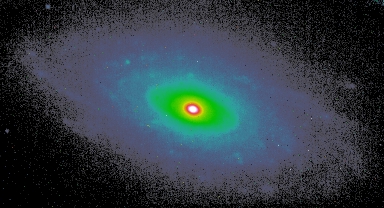
Last changes: 4/2007 © 1999-2007